Comics as art
“Words and pictures are yin and yang. Married, they produce a progeny more interesting than either parent.” ― Dr. Seuss
Doing this column, with its necessary research and the knowledge gained from that research, has, by default, gained me some sort of notoriety as a supposedly informed individual about those peculiar Canadian wartime comic books and the people behind them. Similarly, by default, I have developed and expressed my own opinions about the worth of certain creators and the characters they offered up, as well as about the limits and scope of these books when I use the term ‘WECA books’ to set certain parameters. But these opinions are just that, my own opinions and not an attempt at establishing an orthodoxy (only at a little bit of precision when it comes my development and use of the term ‘WECA comics’).
The latest opportunity I’ve been given as a result of this is to present a talk on these comics at the RiverBrink Art Museum in Queenston. The talk will be on Sunday September 27th at 2pm (I understand there is actually an admission fee of $10). As a topic I’ve decided to talk about the relationship of fine art and WECA comics. We’ll take a look at artists who were already established as fine artists, such as Adrian Dingle, The Kulbach twins, Oscar Shllienger, and Avrom Yanovsky, and then “stooped down” to do these war time Canadian comics. We’ll also look at those young teenagers, many still in high school, such as Murray Karn, Jack Tremblay, and Gerald Lazare who were still learning their craft in the in the comics and then developed enduring careers in commercial and fine art.
My difficulty with this whole thing is the actual fact of giving a talk on comic books at a fine art museum. There has been a deep and longstanding suspicion about comic books being art at all. From the beginning, and they’ve only been around in the form we know for about 80 years, comic books have been made to be remaindered. They were disposable, like Kleenex after one or two uses. Parents were always telling us to stop reading them and do something more edifying (I learned to love reading and probably learned to read through comic books). Many actually tore up, threw away or gave away our comic hoards.
A painting, a sculpture, or a symphony is created for repeated use and is clearly fashioned to endure. It is the original that bears the weight as a work of art and copies or prints or any other subsequent iterations are of appreciably diminished stature. Comics on the other hand, though they have a single original at their source, carry their cultural weight and popular appreciation in the copies stamped from the original, though in recent years the recognition of the worth of original comic art pages has increased geometrically. Fine art is built on a stone base while comics are built on sand, but does that make them any less interesting or without any intrinsic worth?
Neither fine art nor comic books are created for critics. They are both meant to be “read,” to engage and challenge their audience. Even in comic books, a relationship is built between the sequence of panels and the reader. The comic panel illustrator builds a narrative snapshot by snapshot — sometimes the narrative is done for him and sometimes it’s his own, but his illustrations are a translation of that narrative meant to draw the reader in. Even in the most banal comics, we project ourselves into the panel.
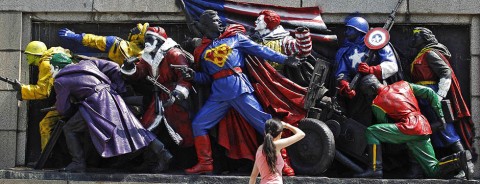
Art presents moments in which we find out who we are. In its best form it gives us a glimpse of something of worth up ahead just disappearing around a corner, something we can never quite fully get to. Very often it fills in the gaps between things rather than just revealing the things themselves. The best of comic books can do this in their combination of drawing and sequential narrative.
But the aim of comics doesn’t have to be so lofty and noble. When I read those post-Fantastic Four #1 Marvels in the early sixties as they hit the stands (and even those pre-hero monster books) it was just plain wide-eyed fun. What was the imagination of these creators going to show us next (in fact we anticipate the CGI wonder that will be thrown at is when attending a Marvel movie nowadays in the same way). You can’t forget the role of nostalgia in this whole enterprise as well and when we read any comic we are reading those first comics over again.
I’m one of those lucky collectors who has somehow managed to keep those comics he first bought off the shelves from over 50 years ago. I confess I’m lost in today’s world of graphic novels, direct sale comics and corporate Fan Cons.
However, if during my talk, I’m asked whether I consider comics as art, I’m not sure how I should or will answer. What is the best way to answer this question and what examples are best to offer up (I welcome any suggestions)? I know that Lichtenstein was co-opted by the fine art world to represent comic culture in the sixties, that Spiegelman’s Maus won a Pulitzer in 1992, and that many leading Museums and Art Galleries, including the Louvre, have featured solid displays of comic art. Publishers IDW opened The San Diego Comic Art Gallery this past June.

I know that comics are highly collectible and can command astronomic prices as can original art pages. I know that comics have their classic masters (and just as in the fine art world, these artists become their body of work once they pass away), their schools and genres, and their body of critics. Just as museum pieces can produce an “I get it.” brain and soul buoyancy in the viewer, certain comics can evoke similar aesthetic sensibilities. But I don’t think there is anything like a Comic Con or Artist’s Alley in the gallery art world. A fine artist feels a field of sunflowers, figures on a hillside, a reclining nude, or an abstract emotion and translates that for the reader. A comic book artist, most often, is attempting to translate his own perception of a narrative through the slow motion strobe light of sequential panels.
If Banksy did a one-off original comic book and left it on a subway seat, would it turn out to be worth more than Action No. 1?
Let me know if you have any views on comic books as art and what comic pages you would place in a gallery or museum exhibit. I’d certainly like to have more ammunition for that talk if the question comes up.
Joke Comics No. 11
For the last couple of years I’ve consistently asked collectors who have significant Canadian wartime comic collections whether or not they have a copy of Bell Features’ Joke Comics No. 11. Though there aren’t great numbers of these collections around, nobody had ever come across a copy. The microfiche edition of the Bell Features collection at the Library and Archives up in Ottawa doesn’t include a version for this book (of course, the microfiche does have a number of other holes because it just represents what the holdings themselves are).
Now, I think I can say with a solid amount of certainty that a Joke Comics No. 11 was never printed. It looks to me that Bell Features simply skipped over No. 11 and went right from No. 10 to No. 12 for some reason; probably simple human error somewhere along the production line. There is a similar precedent in the run of Wow Comics. There is no, by coincidence, properly numbered Wow Comics No. 11. Instead, production error produced two consecutive copies with a cover number of 10. Here are the two covers and the pirate cover is the true No. 11.
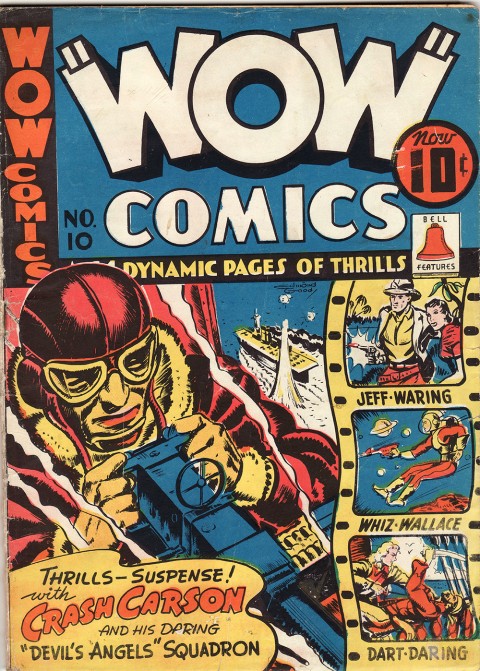
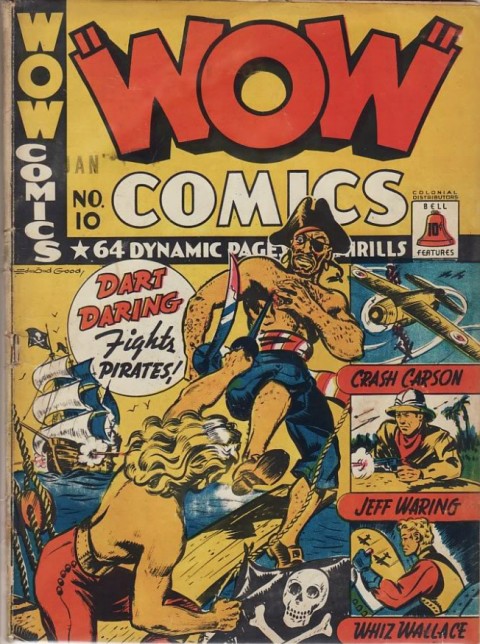
But back to the gap between Joke 10 and Joke 12. There are two continuing series in these two books: Ross Saakel’s “Spike and Mike” and Ted Steele’s “Pvt. Stuff.” The “Spike and Mike” story in Joke Comics No. 10 is the second installment in the “Mike and Spike on the Moon” arc which ran from Joke Comics No. 9 to No. 13.
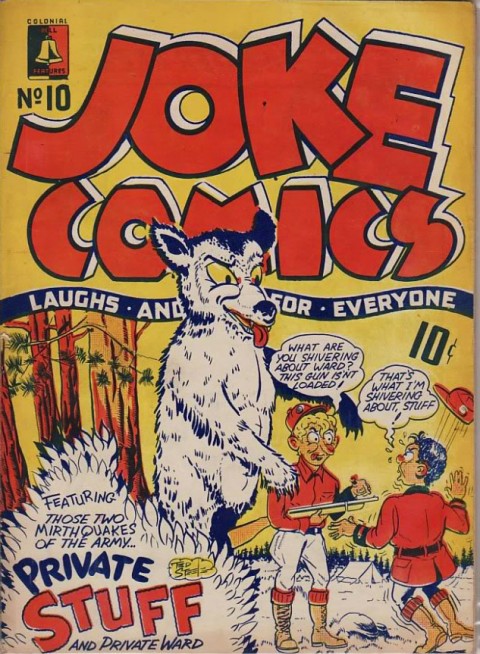
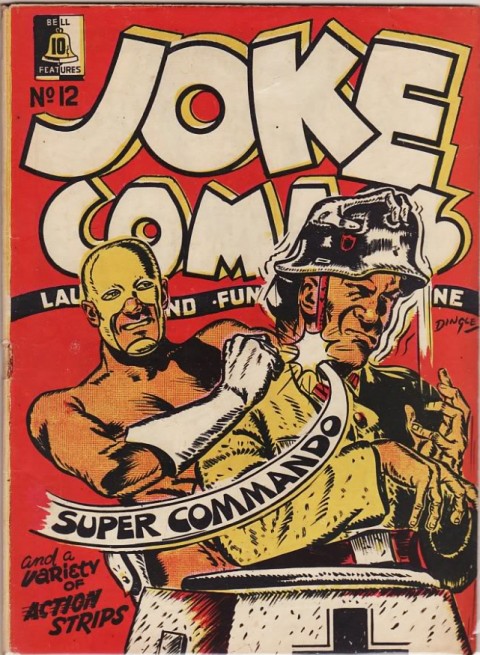
In Joke Comics No. 9 the boys find themselves threatened by an old maid who has designs on Mike and in running away from this manage run into a scientist who has just invented a rocket that he wants the boys to try out and they take off in it just as the old maid finds out where they are. In the last panel of issue 10 they manage to land the rocket and radio back to the scientist that some kind of monster is approaching. The splash page for the “Spike and Mike” in Joke Comics No. 12 is a seamless continuation from the last panel in issue 10. The monster is revealed and it’s closing in on our two heroes. The synopsis of the story so far also describes what has happened in issues 9 and 10 only.
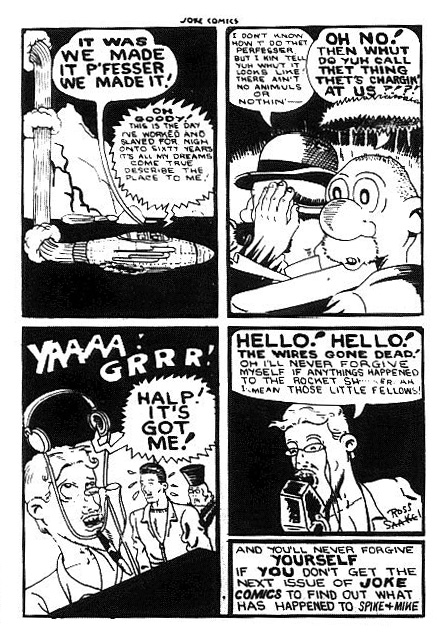
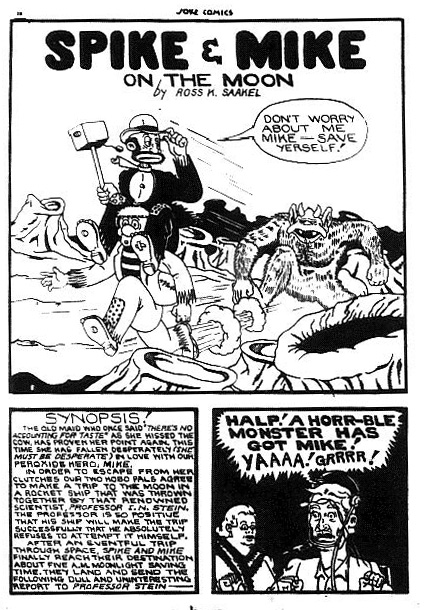
The “Pvt. Stuff” story in Joke Comics No. 10 starts with Stuff and his pal Pvt. Ward enjoying a month’s leave from the army by going on a hunting trip in the Canadian north. After a couple of campground adventures they head on down the river in their canoe but quickly fall asleep and wake up to find themselves, in the last couple of panels, dangling over the very edge of a giant waterfall. The first page of the Stuff story in Joke Comics No. 12, again, is seamless with the one in issue 10. It shows the boys at the top of the waterfall and going right over.
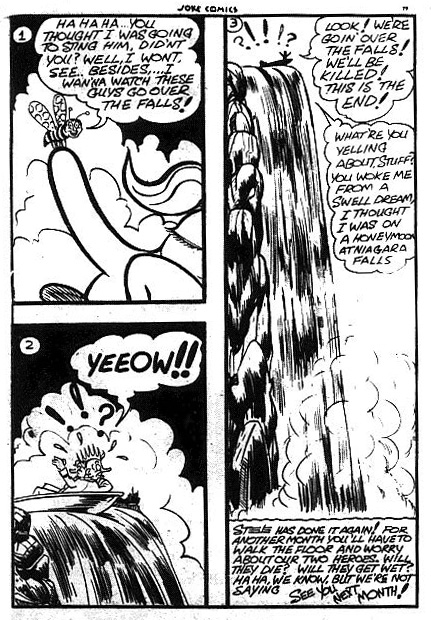
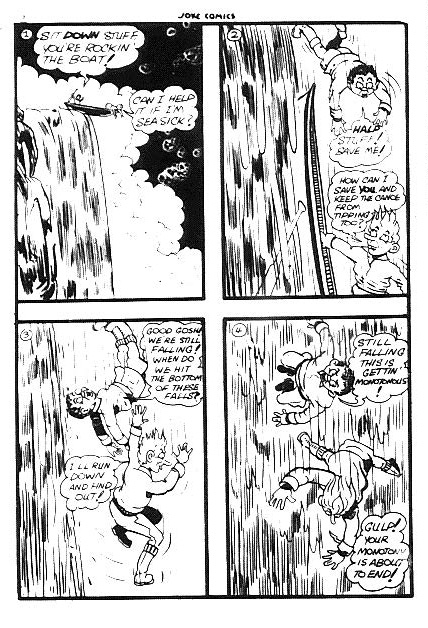
There is nowhere for a Joke Comics No. 11 to fit in between the end panels of the stories in issue 10 and the first panels of the stories in issue 12. On the basis of this evidence I have to assert that Joke Comics No. 11 was never published and the title skipped an issue number between 10 and 12 probably due to some human error.
As a postscript, now that heart of the con season is over with the Labour Day end to Fan Expo, there is a bit of a wind down with Hamilton’s Hammer Con on Oct. 3-4 and London’s one day Forest City Con on Oct. 18th. The Joe Shuster Awards website has announced that this year’s award ceremony will be held at Forest City Con on Oct. 18th. It hasn’t been announced what time of day the ceremony will be held or what the specific room venue will be, but if you’re going to attend the con try and make a point of taking in these awards: you might be sitting next to one of the winners and it’s a chance to see a lot of great Canadian creators in one place that isn’t an Artists Alley.

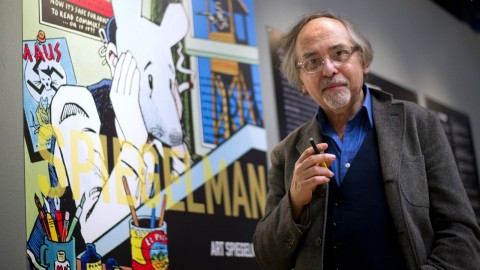
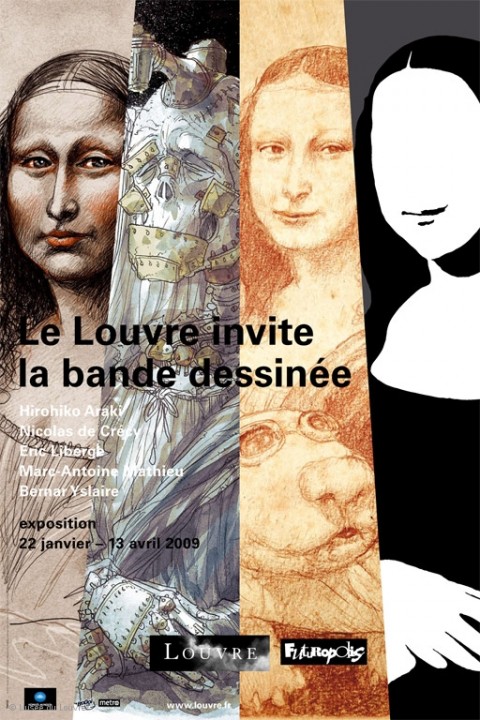
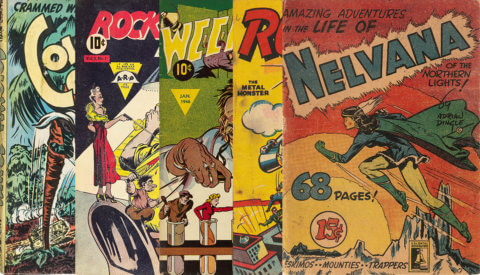
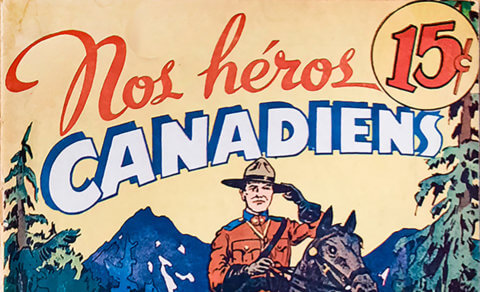
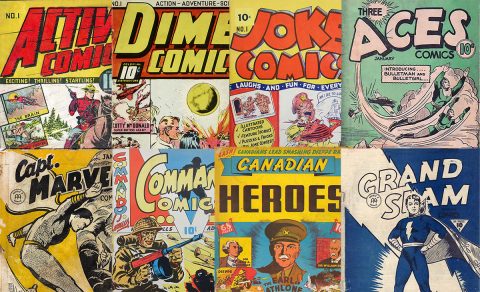
According to the definition of art from the art world, any thing and every thing is art… in which case comics IS art… by their own definition. However, the art world does NOT know what art is. These days, “art” is a catch all term to describe any sort of expression. Therefore, “art” is a meaningless word. The word “art” is simply used to explain away an act or a creation or sometimes nothing at all.
It’s natural for comics to be continually compared to art but I would encourage the comics world to distance themselves away from the art world and take ownership of their own sub culture. Comics don’t need to be “art” in order for it to be enjoyed, nor should it aspire to be art in order to garner respect through association. Art is a dying religion. 1000 years from now, I highly doubt that historians will be looking at the work of Jeff Koons or Damien Hirst to define our culture. Instead, it will be commercialism that provide the anthropological insight that they seek.
As it was with Woman of Willendorf from 24000 BCE, as it was with the religious painters pre 1400’s, impressionist and post impressionist… the key aspect to art will be to see how we use to live. And how we live today wont be defined by the likes of Jeff Koons except in the way he is able to cash in big with his convoluted works. How we live today will be defined by Nike, Apple… Coke, and yes… the rise and eventual fall of comic books.
Art is a justification for its own existence. Comic books don’t need to be explained. It’s a simple reflection of our tastes and interests, which says more about us than Damien Hirst $100 million diamond studded skull:
https://www.youtube.com/watch?v=3tXIYBFbUjs
Thanks for your thoughtful and honest response, Charlie. It belies the training and background you obviously have in the field.
What concerns me about a definition that includes everything does make it frivolous and as you say “meaningless.” It would have to include that image of the 3 year old boy face down on the beach in Turkey; it would have to include the Holocaust (though the commandants could listen to Schubert with tears in their eyes at night and still do what they did); it would have to include every stupid thing we see on the newscasts every day. It’s a wild card cop-out to say that everything is art without any moral limits. Pushing the button that blows up the world is the ultimate work of art, but only for the person who pushes it.
I can’t fully agree with your reduction of the phenomenon we call “art” (including mother earth figurines, cave paintings, medieval religious paintings, and everything that has happened in art since) to a series of sociological phenomena but it does make us think. Fads and tastes and socio-cultural application are part of art but they do not, in my thought, exhaust what art is.
One difference between the creation of comic art and what we call fine art that just occurs to me is that comic art is, almost all of the time, commercial art. It is created for a salary or a commission and only rarely without the constraints of some sort of contract. The comics artist is almost always working for someone else. The fine art artist is more often liberated from these limits and is creating through himself and for himself and the hope that there is some sort of audience out there that may get it. However, both of them have an equally difficult time of making a living for their families.
Charlie, I value your comments and your column, which should be read by everybody who opens the door to Comic Book Daily who wants an informed and well-written take on our passion with collecting comics
Not to start something but most European “fine” art that we are all very familiar with was commercial art, in the aspect that it was done as a commission or the artist had a patron. In either case the artist was being paid to produce the artwork.
You have a good point, Scott. I don’t know enough about the history of art to make a solid comment, but I do know that even through the Renaissance and Baroque periods artists were really seen as people who worked with their hands and patrons would order works of portraiture, religious paintings, architecture, furniture, etc. much like we order fast food today. It was a sort of slave and master relationship. As we moved into modern times patrons seemed to become people who provided artists with the funds to live and for the materials they needed to create the art the artists wanted to create. Patrons, like the gallery owner, try to create audiences for their artists they display. One of the consistent points that artists who I’ve interviewed who started off in comics, moved to commercial art and then on to working as fine artist make is that when they reach that stage they are finally not told what to do nor are they working for anyone else but themselves and their own creative demands.
Hi Ivan. I’m not sure I follow your meaning regarding recent news. The point of journalism is to report and document (although some have argued that objectivity is not possible). And morality is a complicated topic in itself. I’m not saying that I believe art is a “series of sociological phenomena” but it is how art history is formally taught by the academic community. I agree that there is more to art beyond context (and I’m sure that the academic community would also agree) but how do you teach its history any other way? Anything outside of the greater community becomes a personal journey. Thus, I would argue that it’s the things we share that are more interesting. Stories are written, not for the author but for the community and it is the effect of the story (or art) that gives it significance (Watchmen, Dark Knight). Its the chemistry, the cause and effect results that provide insight to our nature. Self discovery is great… for the individual, but communal discovery is a shared experience. This is why I say that the likes of Jeff Koons does not matter as much as the art community likes to think. It is the conditions that have produced Jeff Koons that is much more meaningful… and we can attribute this to Nike, Coke and Apple for having created the climate.
Comics are right in the middle of what I consider to be the new art: Commercialism. However, I’m not sure that definitions really matter in this conversation. All artists got paid. Those who didn’t changed vocation or starved and died. My point is simply that comics don’t need to be defined any other way in order for it to be justified. It can and should exist on it’s own. Anything else is like breast implants… Some may like large fake boobs but being genuine is a rare thing in our world so I hope comics won’t loose this quality.
You ask: Let me know if you have any views on comic books as art and what comic pages you would place in a gallery or museum exhibit.
My response: I would place 1970’s comics, indiscriminately on a shaggy carpet between a plaid pattern couch and a large wooden TV featuring Laverne & Shirley. Also throw in Bazooka Joe gum wrappers and grape Fanta next to the comics. Historians would love it!
Slave and master relationship?
I guess I mean that, if there are no limits on what art is (i.e., if anything can be art, then every act in the world can be seen as a work of art so that even an act of murder or torture can be seen as making an artistic statement). I don’t think I can accept such a limitless definition of art. The act of the corporal being shot at the veteran’s monument on Parliament Hill just about a year ago is not an artistic act in itself but the editorial cartoon the next day that showed one of the figures in the statue stooping down to pick up the dead soldier and welcome him into a place on the monument was.
I see what you mean when you say that the history of art has to be understood as evolving through its social context but even anonymous, undiscovered artists who’s creations have never been seen by anybody else still create art for themselves. Art can still be art without having any use, including social at all. I think fads and styles and tastes are only a part of what art is.
Charlie, your idea for an artistic installment for 70s comics is a neat one but I see it as a cliché much in the same way Mike Myers reduced the 60s to an Austin Powers movie. Having lived through the 70s as a twenty-something I can assure you that it would a false stamp on what the 70s and those first bronze age comics (which I bought off the stands at the corner store) gave to us.
Some great insights on art and comics, Charlie, thanks for offering them up. It’s great to share and exchange ideas on topics such as this.
I agree that the open ended definition of art from the art world is lame. I understand that they are attempting to capture the spirit of art by suggesting it can be anything (I blame the post modernists) but I find it insufficient and overly PC. This is why I say that the art world does not know what art is or is afraid to define it.
I also never suggested that art must have a use or function otherwise we’d be talking about “applied art” such as commercial art… but things are never black and white, and again, we get into the area of definitions which seems moot for this discussion. We can look at historical facts in order to determine how the wheel was invented but art provides us with things like mood, sentiment, mindset, atmosphere, social interests, influences. It adds flavour to the hard facts. Historically speaking, art is a record of our feelings and emotional state. If you ask me, this has been the one constant throughout all history, from cave paintings to Bansky.
I think it would be more false to put a production page designed for print in a frame and call it art. At least the living room recreation of the 70s would offer insight to the conditions in which comics were enjoyed and used at a particular time period… which is somewhat different than the way comics are enjoyed today. It was just an idea… There are lots of other ways to present this material so I hope you have fun with it.
Thanks for your thoughtful comments and effort to clarify things, Charlie. I hope that someday we can share a conversation face to face. There are so many interesting individuals sharing interesting columns on this site I hope to meet as many of you as possible. Time for a Comic Book Daily get together Walt….
Gentle men, a few chocalite kisses,hopefully not milk duds to toss into the mix. Regards to violence , torture…..these acts should not be considered “art”. Are the works/writings of Marque D’ Sade,his philosophical,his critiques of religious interpretation on Nature, Chaos,Order…..and his minute, concise, brutal ,examination of human beings unrestricted desires and imaginations. “Literary Art”…Thoughts and comments please? For me the comic book is the Art Object, the pages drawn, the stories etc. are part of the process towards the end product. Finally, your opinions on the virtual reality products due to explode on us this holiday season!!
I’m not familiar with Marque D’ Sade but violence, torture and even pornographic images exist in comics as well as art. In fact, many of the well known and popular artist such as Goya often depicted war and nightmares. As well, religious painters were inspired or asked by the Church to capture scenes from the Bible which is chock-full of violence, torture and sex. Case in point, Massacre of the Innocents by Peter Paul Rubens shows babies and their mothers being slaughtered. The biblical story being that King Herod ordered new born babies to be killed after hearing about the coming of Jesus.
https://upload.wikimedia.org/wikipedia/commons/6/6f/Peter_Paul_Rubens_Massacre_of_the_Innocents.jpg
Comics are drawn by hand so people equate the act of drawing with art. However, drawing is only one facet of art. Also there is intent. If the creators of comics intended comics to be art, then we can used the definition from the art community to call it art (ala, Warhol and Lichtenstein) and discuss its merits but as we all know, comics are closer to a can of soda pop than art. Still, by my own personal reasoning… I suggest that commercialism is the new art, and comics as a whole are a component of commercialism, therefore… it is art, in part at least. But the question is, what is it that we are trying to communicate here by calling comics art? Are we trying to say something about the human condition or… are we simply trying to elevate comics by promoting it as art?
very quickly..what i find most interesting about D’ Sade is the ignorance in his works vs the man himself. He was one of the few voices who spoke out in trying to save the Aristocrats from the Guillotine during the French Revolution. Anyway….i agree with your last few sentences. Mixed bag of human vanities, but a very powerfull desire for connection, mergence, transcendence the distillation of commercialization as a filter. But again what are opinions of our viewers in regards to the introduction of Virtual Reality?? We had 3-D and 3D Effect comic books,and ViewMaster—-will these V.R. products fizzle out or bring about profound changes??
correction…should read “….ignorance of his works….”.
Thanks for adding the mind candy, Stephen. The Marquis de Sade has been one of the central figures in literature to make us think about the distinction between literature/art and pornography and where we draw the line for what is obscene (obscenity and censorship tend to go hand in hand and this, in itself is a weird concept because the people who censor are no better or different than we who are told we can’t view or read certain things and also because those who really want to have access to what is censored will get it anyway). Pornography is the ultimate in commercialism. It’s made its home better than any other aspect (blemish?) of our culture but I don’t think it can be art because its possibilities and scenarios are limited and finite (body parts can only fit together in a limited number of ways). Its use is one pointed and obvious and it survives by repeating a limited number of banal clichés and quickly exhausts its possibilities. It seems to have a contempt for its audience by leaving nothing to the imagination. it has to show everything and that in close up. Art, I think, does the opposite. It trusts the viewer and reader to fill in the blanks and spaces with his/her imagination, intelligence, and sensitivity by pointing beyond itself and back at the reader.
In a strange way, I’ve seen this tendency creeping into modern TV over the last decade or so where autopsies and dismemberment have to be spelled out for the viewer in crime shows and murders are shown in graphic, slow motion, close up (an extrapolation of Peckinpah’s 1969 western “The Wild Bunch”). The imagination now has to work less. This makes me think about what advances in CGI have contributed to comic book and SF movies. To me, CGI has finally caught up with what was in our heads when we originally read our comic as kids and I eagerly look forward in anticipation to the new super hero or Star Wars movie to see what they will throw at us next. I don’t know if these advances in CGI will lead to an atrophy of our imagination muscle over the next generation or whether it will allow it to take off in directions we never thought of before, but I do know that it makes watching these movies a lot more fun. I wonder if there will ever be a CGI to fill in our imagination about our own sensitive, moral limits, and place in the world the way that art and literature do?
<>
Isn’t this a description of mainstream comics as well? How many more Secret Wars can we have? How many more Infinite Crisis? How many more stories that start with… My name is Bruce Banner or Wolverine or who ever happens to be narrating in the first person. How many more times can we use the term “love letter” or “intergalactic soap opera” to describe the same thing over and over again?
<>
I couldn’t agree more… and yet, the people in comics, as well a porn all look for legitimacy. But whats interesting about all this is… chicken or the egg? Are we being fed what we want or is what we want influenced by what we are fed?
Adult entertainment may not be for you or me but is it really any better or worse than our political system, the bankers, the Kim Kardashians and the Miley Cyrus’ of the world. Vulgarity exists every where. It just a matter of individual preference or what we can tolerate.
Oops… forgot your quotes:
I don’t think it can be art because its possibilities and scenarios are limited and finite
Isn’t this a description of mainstream comics as well? How many more Secret Wars can we have? How many more Infinite Crisis? How many more stories that start with… My name is Bruce Banner or Wolverine or who ever happens to be narrating in the first person. How many more times can we use the term “love letter” or “intergalactic soap opera” to describe the same thing over and over again?
Its use is one pointed and obvious and it survives by repeating a limited number of banal clichés and quickly exhausts its possibilities
I couldn’t agree more… and yet, the people in comics, as well a porn all look for legitimacy. But whats interesting about all this is… chicken or the egg? Are we being fed what we want or is what we want influenced by what we are fed?
Adult entertainment may not be for you or me but is it really any better or worse than our political system, the bankers, the Kim Kardashians and the Miley Cyrus’ of the world. Vulgarity exists every where. It just a matter of individual preference or what we can tolerate.